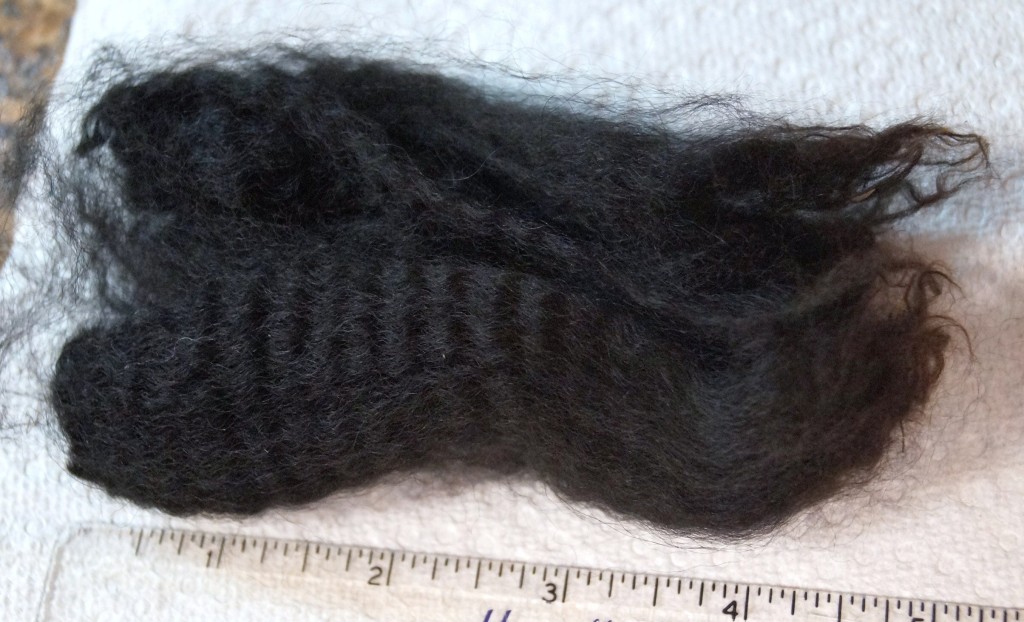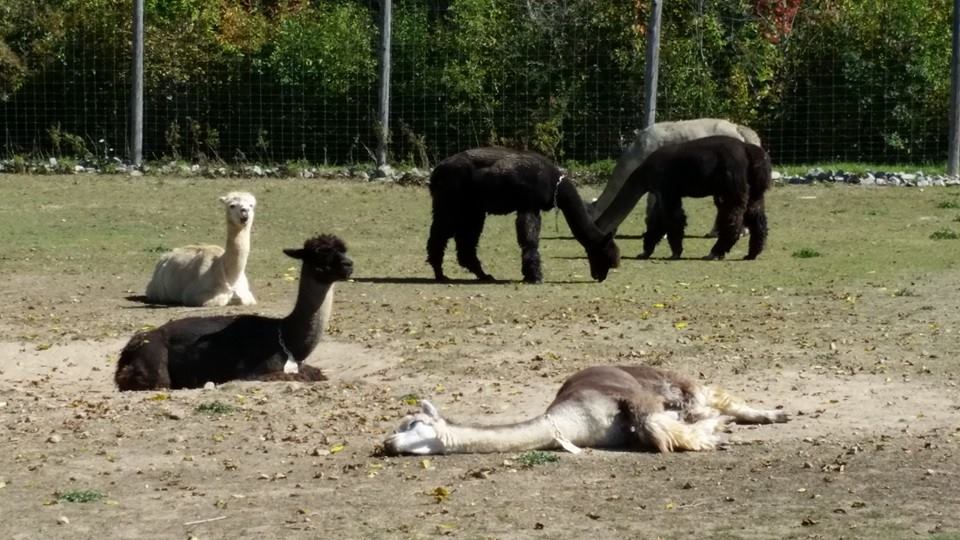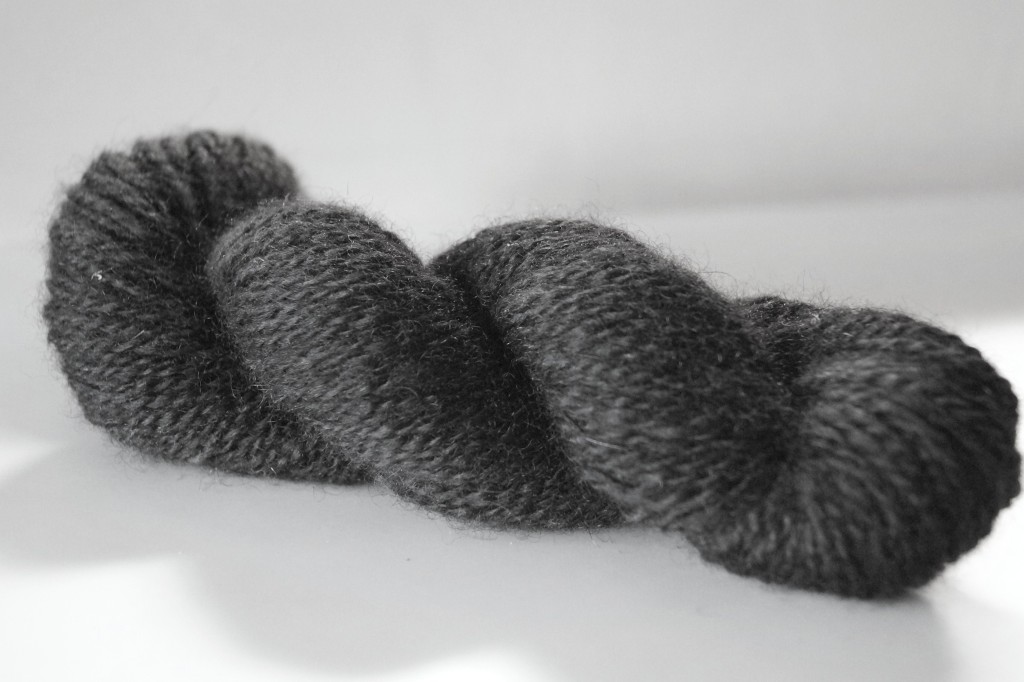I really wish I could have met Fuerig in person. With his glossy black locks and cool demeanor, I could envision him strutting around the paddock like a camelid version of Fabio, beckoning to the ladies housed in the next pasture over with a “hello gorgeous, come here often?” line.
Since the owner sold him for breeding stock before I arrived at the ranch, the next best thing was to acquire 2 of his fleeces. The first fleece being his “cria” fleece (cria is what a baby alpaca is called) with a 4 1/2″ long staple length and slight crimp, the lustrous jet black locks are incredibly soft and as fine as angora bunny fur. Unfortunately it is full of VM (vegetable matter) and the processing mill had sent it back as they didn’t want to deal with all that VM. I figure I have plenty of time to painstakingly pick out bits of hay knowing full well that the end product will be well worth the effort.
 The second fleece was from his next (2nd) shearing, it still needs a light skirting as well as a bath but it is currently housed in an airtight tote bin while I finish processing his baby fleece. I have big plans for both fleeces, but first I was itching to spin some of the baby fleece as its reputation of being an exceptionally soft fiber is prized by knitters the world over.
The second fleece was from his next (2nd) shearing, it still needs a light skirting as well as a bath but it is currently housed in an airtight tote bin while I finish processing his baby fleece. I have big plans for both fleeces, but first I was itching to spin some of the baby fleece as its reputation of being an exceptionally soft fiber is prized by knitters the world over.
For those that have yet to spin alpaca (or other camelid) fibers, the weight and feel of alpaca yarns are nothing like that of yarn made with sheep’s wool. Wool fiber ranges from rough to ultra soft, depending on the breed, they have somewhat denser locks but with a distinct bouncy feel. Alpacas don’t bounce, they just lay flat out on the ground and snooze and their fiber feels exactly the same, heavy and with great draping qualities.
 After a week of picking, washing and drying, the silky black locks were ready for further processing. I automatically chose to use my hand cards for this one over the drum carder for two reasons. First being the drum carder was up north at the cottage and I and the fleece were not and two, the fineness and length of the staples called for a delicate hand while carding so as not to damage or break the fibers. Combing could have been another option for processing, if I had a pair of hand combs that is, but I don’t, so hand cards are the weapon of choice.
After a week of picking, washing and drying, the silky black locks were ready for further processing. I automatically chose to use my hand cards for this one over the drum carder for two reasons. First being the drum carder was up north at the cottage and I and the fleece were not and two, the fineness and length of the staples called for a delicate hand while carding so as not to damage or break the fibers. Combing could have been another option for processing, if I had a pair of hand combs that is, but I don’t, so hand cards are the weapon of choice.
I spent a wet and dreary Saturday afternoon picking and carding 2 ounces of fiber to spin for a test skein. Once prepped into rolags, I divided the batch in half and eagerly sat down with my antique Nova Scotian wheel and got to work. Wow, this fiber spun with ease. So soft and silky and at times a little slippery, but it was a real pleasure to spin, with the exception of stopping to pick VM out occasionally.
I wanted the finished yarn to feel as close to commercially spun baby alpaca yarn as possible. Once your fingers touch one of those soft, squooshy and smooshy hanks of yarn, it’s impossible to put it back down and next thing you know it’s in your shopping bag and your wallet is noticeably lighter. So the trick to getting that baby soft feel is to keep as little twist to the yarn as possible. Only add enough twist to hold the single together if you are keeping it as a single. If you are plying with 2 or more singles, then add a tich more twist, being careful not to add too much though or you will end up with a skein of kitchen twine. Desirable only if you have a turkey to truss.
After I spun a few meters, I pulled a length of the single back off the bobbin and plied it against itself for a sample. Perfect. It was turning out exactly as I envisioned. It was about a light fingering weight for the 2-ply, but that will most likely change with wet finishing, so for now I cut that off and added it to my control card and then spent the next day spinning up a couple bobbins, each holding an ounce of fiber. I let the bobbins rest for a day, and then plied them together into a gorgeous hank of jet black, shiny yarn.
I ended up with 177 yards out of the 2 ounces of fiber and after a wash and set at the salon, the yarn bloomed to 12 wpi, about a DK weight yarn. I was aiming for Fingering weight, but overall was happy with it as the intended project is a shawl and gauge isn’t terribly important in shawls.
With the test skein of Fuerig’s cria fleece complete, I need to finalize what shawl pattern to use. Normally I spin for an already chosen project, like my Fert & Palladin Alpaca Throw Blanket (http://www.ournorthernhomestead.com/meet-fert-and-palladin), but acquiring this fleece at the last minute left me with no time to search for the right pattern beforehand. I was also somewhat affected by the ‘oooo shiny’ syndrome of wanting to play with the fleece immediately after obtaining it. I am sure a lot of fiber enthusiasts out there can relate or attest to the reality of the ‘oooo shiny’ syndrome, it often afflicts even the most disciplined fiber-holic.
Now it’s time to cruise the internet halls of Ravelry, window shopping for shawls from the comfort of my arm chair with a cup of tea in hand, then back to finish spinning up the rest of Fuerig’s fleece…… unless the ‘oooo shiny’ syndrome strikes again.
Deborah

